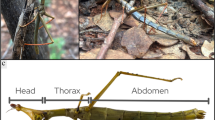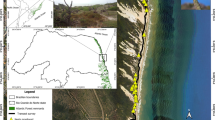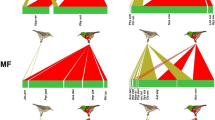Abstract
We compared the feeding ecology of the Hali–Hali community of bonobos (Pan paniscus) at Kokolopori, a new field site in the Democratic Republic of the Congo, between two periods 5 months apart. During the first study period (SP1), bonobos relied heavily on the dry seeds of Guibourtia (Caesalpiniaceae), mostly eaten from the ground. The second period (SP2) was characterized by high consumption of ripe tree fruit. Terrestrial herbaceous vegetation (THV) contributed little to the diet in either study period. The low amount of ripe fruit and the high reliance on seeds in the diet during SP1 were associated with high cortisol production and low levels of urinary C-peptide in females, suggesting nutritional stress. However, female gregariousness was not constrained during the fruit-poor period, probably because high seed abundance on the ground ameliorated scramble feeding competition. This is the first description of extensive seed predation by bonobos. It suggests that bonobo feeding ecology may be more similar to that of chimpanzees than previously recognized.
Similar content being viewed by others
References
Altmann J (1974) Observational study of behavior: sampling methods. Behaviour 49:227–267
Boesch C (1996) Social grouping in Tai chimpanzees. In: McGrew WC, Marchant LF, Nishida T (eds) Great ape societies. Cambridge University Press, Cambridge
Chapman CA, White FJ, Wrangham RW (1994) Party size in chimpanzees and bonobos: a reevaluation of theory based on two similarly forested sites. In: Wrangham RW, McGrew WC, de Waal FBM, Heltne PG (eds) Chimpanzee cultures. Harvard University Press, Cambridge, MA, pp 41–57
Deschner T, Kratzsch J, Hohmann G (2008) Urinary C-peptide as a method for monitoring body mass changes in captive bonobos (Pan paniscus). Horm Behav 54:620–626
Emery Thompson M (2005) Endocrinology and ecology of female chimpanzee reproduction. Ph.D. thesis, Harvard University, Cambridge, MA
Emery Thompson M, Knott CD (2008) Urinary C-peptide of insulin as a non-invasive marker of energy balance in wild orangutans. Horm Behav 53:526–535
Emery Thompson M, Muller MN, Wrangham RW, Lwanga JS, Potts KB (2009) Urinary C-peptide tracks seasonal and individual variation in energy balance in wild chimpanzees. Horm Behav 55:299–305
Emery Thompson M, Muller MN, Kahlenberg SM, Wrangham RW (2010) Dynamics of social and energetic stress in wild female chimpanzees. Horm Behav 58:440–449
Furuichi T (2009) Factors underlying party size differences between chimpanzees and bonobos: a review and hypotheses for future study. Primates 50:197–209
Georgiev AV, Lokasola AL, Nkanga L, Lokondja A, Nsala J, Likenge J, Ilanga-Bomanga A, Likenge JP (2010) New observations of the terrestrial holoparasite Chlamydophytum aphyllum Mildbr. and its consumption by bonobos at Kokolopori, Democratic Republic of Congo. Afr J Ecol 48:849–852
Gilby IC, Pokempner AA, Wrangham RW (2010) A direct comparison of scan and focal sampling methods for measuring wild chimpanzee feeding behaviour. Folia Primatol 81:254–264
Girard-Buttoz C, Higham JP, Heistermann M, Wedegärtner S, Maestripieri D, Engelhardt A (2011) Urinary C-peptide measurement as a maker of nutritional status in macaques. PLoS One 6(e18043):1–9
Goodall J (1986) The chimpanzees of Gombe: patterns of behavior. The Belknap Press of Harvard University Press, Cambridge, pp 674
Harris TR, Chapman CA, Monfort SL (2010) Small folivorous primate groups exhibit behavioral and physiological effects of food scarcity. Behav Ecol 21:46–56
Harrison M, Marshall A (2011) Strategies for the use of fallback foods in apes. Int J Primatol. doi:10.1007/s10764-010-9487-2
Higham JP, Heistermann M, Maestripieri D (2011) The energetics of male–male endurance rivalry in free-ranging rhesus macaques, Macaca mulatta. Anim Behav 81:1001–1007
Hohmann G, Fowler A, Sommer V, Ortmann S (2006) Frugivory and gregariousness of Salonga bonobos and Gashaka chimpanzees: the influence of abundance and nutritional quality of fruit. In: Hohmann G, Robbins MM, Boesch C (eds) Feeding ecology in apes and other primates: ecological, physical and behavioural aspects. Cambridge University Press, Cambridge, pp 123–159
Idani G (1986) Seed dispersal by pygmy chimpanzees (Pan paniscus)—a preliminary report. Primates 27:441–447
Idani G, Kuroda S, Kano T, Asato R (1994) Flora and vegetation of Wamba forest, central Zaire with reference to bonobo (Pan paniscus) foods at Wamba. Tropics 3:309–332
Lambert JE (2011) Primate seed dispersers as umbrella species: a case study from Kibale National Park, Uganda, with implications for Afrotropical forest conservation. Am J Primatol 73:9–24
Norconk MA, Grafton BW, Conklin-Brittain NL (1998) Seed dispersal by neotropical seed predators. Am J Primatol 45:103–126
Reynolds V (2005) The chimpanzees of Budongo Forest: ecology. behaviour and conservation. Oxford University Press, Oxford
Rogers ME, Maisels F, Williamson EA, Fernandez M, Tutin CEG (1990) Gorilla diet in the Lope Reserve, Gabon: a nutritional analysis. Oecologia 84:326–339
Sherry DS, Ellison PE (2007) Potential applications of urinary C-peptide of insulin for comparative energetics research. Am J Phys Anthropol 133:771–778
Sommer V, Bauer J, Fowler A, Ortmann S (2010) Patriarchal chimpanzees, matriarchal bonobos: potential ecological causes of a Pan dichotomy. In: Sommer V, Ross C (eds) Primates of Gashaka: socioecology and conservation in Nigeria’s biodiversity hotspot. Springer, New York
Sugiyama Y (1968) Social organization of chimpanzees in the Budongo Forest, Uganda. Primates 9:225–258
Suzuki A (1969) An ecological study of chimpanzees in a savanna woodland. Primates 10:103–148
Tsuji Y, Yangozene K, Sakamaki T (2010) Estimation of seed dispersal distance by the bonobo, Pan paniscus, in a tropical forest in Democratic Republic of Congo. J Trop Ecol 26:115–118
Wallace R (2005) Seasonal variations in diet and foraging behavior of Ateles chamek in a Southern Amazonian Tropical Forest. Int J Primatol 26:1053–1075
White F, Wrangham RW (1988) Feeding competition and patch size in the chimpanzee species Pan paniscus and Pan troglodytes. Behaviour 105:148–164
Wrangham RW (1975) The behavioural ecology of chimpanzees in Gombe National Park, Tanzania (Ph.D. thesis). Cambridge University, Cambridge
Wrangham RW (2000) Why are male chimpanzees more gregarious than mothers? A scramble competition hypothesis. In: Kappeler P (ed) Primate males: causes and consequences of variation in group composition. Cambridge University Press, Cambridge, pp 248–258
Acknowledgments
We thank Sally Coxe and Michael Hurley from the Bonobo Conservation Initiative (BCI) for the invitation to work at Kokolopori and for their support in the field. Our study was made possible by research permission obtained by the BCI and with the cooperation of Dr. Mwanza Ndunda at the Centre Recherche de Ecologie et Forestrie at Mbandaka. BCI staff in Kinshasa and Mbandka, the late Veronique Lokasola, and her colleagues at Vie Sauvage provided guidance and assistance in the DRC. Barbara McKinder arranged access to and helped track down specimens at the Royal Botanical Gardens Kew. Leonard Nkanga, Antoine Lokondja, Jean Nsala, Jacques Likenge, Antoine Ilanga-Bomanga and Jean-Pierre Likenge assisted in the field. For their help before, during and in-between trips, AG would further like to thank the late B. Carey, D. Carey, M. Reiches, E. Aggianiotakis and M. Lynch. Funding was provided by Harvard University, the Arthur L. Greene Fund, and a Bristol Myers Freedom to Discover Award to B. Hahn at University of Alabama at Birmingham. We also thank Takeshi Furuichi and an anonymous reviewer for their valuable comments on the manuscript. This study complied with the requirements of the Institutional Animal Care and Use Committee (IACUC) of the Faculty of Arts and Sciences at Harvard University, as well as with relevant legislation of the host country, the Democratic Republic of the Congo.
Author information
Authors and Affiliations
Corresponding author
Electronic supplementary material
Below is the link to the electronic supplementary material.
About this article
Cite this article
Georgiev, A.V., Thompson, M.E., Lokasola, A.L. et al. Seed predation by bonobos (Pan paniscus) at Kokolopori, Democratic Republic of the Congo. Primates 52, 309–314 (2011). https://doi.org/10.1007/s10329-011-0256-4
Received:
Accepted:
Published:
Issue Date:
DOI: https://doi.org/10.1007/s10329-011-0256-4




